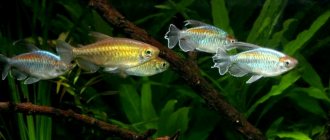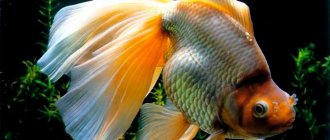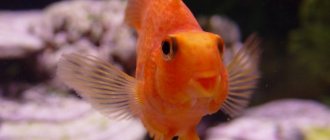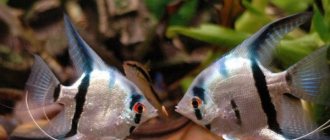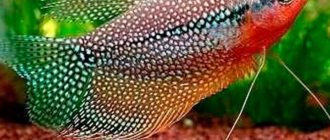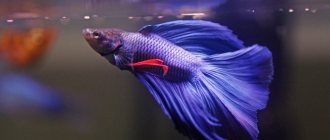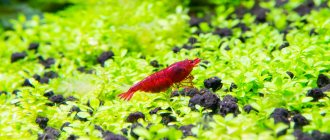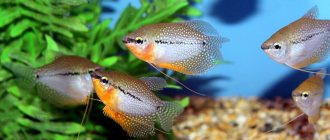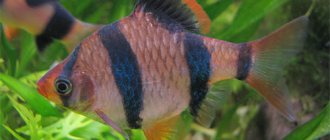A colorful representative of decorative aquarium fish belonging to the cyprinid group is the comet fish. It will become a decoration for your aquarium, as it is one of the most beautiful fish and also gets along well with all peaceful fish. Those who are fond of collecting fish have given it a second name - “goldfish”. Representatives of this type of aquarium fish are very clean, which refutes the idea that they can pollute the aquarium. To avoid this situation, you just need to get a couple of catfish, as they are excellent aquarium cleaners.
Description and characteristics
Comet goldfish is the result of the hard work of specialists who, thanks to painstaking work, developed this species. It is believed that the birthplace of the fish is the USA, but some experts claim that the species was bred in Japan. In some countries, aquarium comet fish are called Mabel, and the phenotype is valued for its unusual and beautiful appearance. Indeed, the description of the appearance of goldfish comets is excellent: Mabel has a luxurious forked tail, the ends of which gracefully develop in the water, like bright ribbons. The size of the caudal fin is also noteworthy - it exceeds the length of the fish’s body by two or even three times. In professional aquarium circles, it is believed that the longer the tail, the more expensive the specimen.
The body of aquarium golden mabels is oblong, slightly elongated in length and is the standard of the species. If the outlines of the body and abdomen have rounded shapes, then this is considered a defect. In addition to the tail, aquarium fish comets have a well-formed dorsal fin, and the color is striking in the brightness and richness of the colors. Depending on the shade of their scales, fish are divided into several subspecies:
- red comet;
- yellow mabel;
- black comet;
- golden mabel;
- silver mabel
The most valuable are fish with different body and fin colors: for example, in some specimens the color includes a basic orange or scarlet background with snow-white or yellow spots - this is a red-and-white comet. The most expensive subspecies is considered to be the Mabel called “black velvet” - an aquarium fish of a jet-black hue.
The color saturation and shades of color in the phenotype may vary depending on the conditions in the aquarium and nutrition. If a comfortable environment is created for the Mabel fish, in compliance with the rules of cultivation, then golden comets live in an aquarium for up to 14 years.
Goldfish: Calico comet - 5-6 cm
Description Calico comet (Carassius auratus var.)
A comet is an ordinary goldfish with a slightly raised back and an elongated, ribbon-like caudal fin with identical ends. In some species of this breed, the length of the tail is three to four times longer than the body of the fish. Both blades of the tail are also very elongated and form a fork. Often, this elongated tail is also accompanied by extremely long pectoral and pelvic fins, hanging down in the form of ribbons.
Among comets, silver fish with a bright red or lemon yellow tail are especially prized. Fish with red and white spots on the body are especially attractive. There is also a veil comet.
Habitat:
Selectively bred form of Goldfish (Carassius auratus).
Contents in the aquarium:
Fish live at room temperature and do not require heating. In small vessels with fish, abundant aeration of the water is necessary - air blowing. It is possible to keep it with other non-predatory fish species, especially those that are not prone to biting fins. It should be remembered that ornamental types of goldfish are poorly adapted to competition, including for food.
It is better to keep goldfish in a spacious large aquarium (from 200 l). You can, of course, use 50 liters, but as the practice and experience of many aquarists shows, in large aquariums goldfish feel better, grow larger, and also due to the conditions described below for keeping goldfish. The number of individuals is approximately 1 fish per 40-50 liters.
It is better to use either coarse-grained or fine-grained soil in the aquarium, because... goldfish are constantly sorting through the stones, and can eat a little of them. In the scenery it is necessary to refrain from the following elements: castles, ships, etc., because fish can damage their fins, eyes and much more.
It is better to use live plants, although many recommend artificial ones. To prevent the vegetation from being completely eaten, you can use hard-leaved plants that goldfish do not touch - lemongrass, anubias, cryptocorynes, echinodorus, etc. Such plants will not be eaten and will serve as additional environmental stabilizers in the aquarium.
In order to prevent the fish from rummaging in the soil from pulling out plants by the roots each time, when planting them, the bottom around the roots can be covered with larger rounded pebbles on top of the soil.
Important! Do not use hard plants with sharp and cutting leaves in a goldfish aquarium, because... they can damage the fish.
The temperature in the aquarium should be between 21-240C. Although these fish can tolerate cool water (from 100C), they do not look very good at this temperature. You also need to take into account that if the temperature is too high (26-280C), the fish age faster. In general, the temperature range for keeping goldfish is 10-280C.
Important! Fish such as telescopes, ranchu, lionheads are considered more heat-loving fish (temperature 250C).
In an aquarium with goldfish, it is necessary to have good water aeration, because... they love water with a high oxygen content. It is also necessary to have a good filter, because... Goldfish litter a lot, although they themselves love clean water.
The limits of water hardness (dH) are 6-20°, acidity (pH) – 5-8.
Compatibility:
Calm in nature, peaceful goldfish get along well with equally calm neighbors, but it is preferable to keep only decorative forms of goldfish in one aquarium.
Breeding:
In good conditions, goldfish become sexually mature by about a year. When a male is ready for spawning, small white tubercles (tubercules) form on his gill covers, resembling semolina grains in appearance. A signal for spawning can be a steady increase in temperature by several degrees, often in combination with changes in water parameters for the better (for example, a significant, more than 30%, water change in the aquarium). Often, spawning is encouraged by transporting individuals ready for spawning and transplanting them into new conditions, especially if the temperature in the new place is higher. External signs of the beginning of spawning are the activity of the male, expressed in energetic pursuit of the female and frequent blows with his mouth in the area of her anus (thus the male encourages the female to spawn). When such signs appear, the breeders are transplanted into a separate, preferably spacious, aquarium with temperature and water parameters identical to those in the general aquarium. It is good to place dense floating plants (Java moss, hornwort, nayas) in the spawning aquarium. During unscheduled spawning, the aquarist can only observe its progress.
On average, a large adult fish can spawn up to 3 thousand eggs during the entire spawning period, while small fish can lay much less. Goldfish eggs are up to 1 mm in size, initially translucent, slightly yellowish in color.
Since goldfish eat their eggs, after spawning the spawners must be removed or carefully collected and transferred to another container. Embryonic development lasts from 2 to 5 days, after which larvae emerge from the eggs. All this time it is necessary to maintain a constant temperature of 22-250C and intense lighting.
As soon as the fry begin to move independently in search of food, they need to be fed intensively. The best food at this time is live dust (tiny plankton consisting of rotifers, ciliates, etc.). A good starting food for fry is the slipper ciliate, which is usually not difficult to breed at home. The smallest algae (blooming water) can be a good addition. By the 15th - 20th day of life, the fry has a well-defined caudal fin, and the anal and dorsal fins begin to function. By about 25-30 days, the caudal fin of short-bodied breeds bifurcates. By that time, the fry can reach a size of 12 - 15 mm. A little later, by one and a half months, the scales become clearly visible.
Feeding:
You need to feed goldens once or twice a day in small portions, so that everything is eaten in 5-10 minutes or less (if you feed twice a day, halve the portions accordingly).
Goldfish are omnivores. Therefore, their diet should be varied. This includes live food (you need to be careful with them; pathogens of dangerous diseases often enter the aquarium along with live food; frozen food is safer in this regard), plant food, and specialized food for goldfish produced by a number of manufacturers (for example, Sera, Tetra).
Before feeding, it is advisable to soak dry food (both flakes and, especially, granules) in a saucer with aquarium water for several minutes. Otherwise, there is a risk that food particles that swell after eating will cause digestive system upset.
Frozen food must be thawed before feeding, brought to room temperature, and fed immediately after defrosting. When feeding frozen brine shrimp to juveniles, it is recommended to soak it in water in order to eliminate excessive salt concentration.
Important! Re-freezing of food is not allowed!
It is also necessary to include various plant foods in the diet, such as lettuce, cucumber, dill, cabbage, nettle, etc. All this is scalded, finely chopped and served to the fish. Adult fish are able to eat, for example, lettuce leaves without scalding, and sometimes without the need for fine cutting. Fruits (orange, kiwi, etc.) will also be a good addition to the diet.
Some aquarium plants are also good plant food - duckweed, riccia, hornwort. Hornwort is doubly useful due to the fact that, being a fast-growing plant, it intensively absorbs nitrogen from water, thereby helping to reduce the concentration of nitrates.
Many experts recommend introducing into the diet porridges cooked from various grains in water (without salt). It is desirable that these porridges have a crumbly structure.
Contents in an artificial reservoir
Keeping and caring for Mabel in an aquarium will not cause any difficulties even for a novice aquarist, but some conditions must still be met in order for the pets to feel comfortable and well. First of all, you need a spacious tank, since the fish are quite elongated in length. To contain one specimen you will need a container with a capacity of 55 liters. The aquarium must be equipped with a lid to prevent pets from jumping out, and comet fish are capable of this, given their mobility and energy.
Water indicators:
- hardness – 5–17 dH;
- acidity – up to 8 pH;
- water temperature – 20–24C.
An important circumstance for the aquarist, which the owner must observe, is the weekly replacement of ¼ of the volume of water so that the fish are not plagued by illness and stress. A filter and an aerator are also installed in the aquarium, since phenotypes are not distinguished by their love of cleanliness and order, and are happy to clog the tank. Vegetation for a pond with aquarium fish is chosen with hard leaves and developed roots, because Mabel loves to dig in the ground. Ideal options for a tank are plants such as:
- nomaphyla straight;
- elodea;
- Vallisneria;
- egg capsule
Experienced aquarists who grow comets install fluorescent light bulbs in the tank, thanks to which the fish look bright and colorful.
Appearance
Comet fish are very beautiful and very unusual in appearance. The body is somewhat elongated and ends with a luxurious forked caudal fin, which makes it look like a veil tail. The length of the fin reaches ¾ of the body length. The longer the tail, the more valuable the aquarium fish. The dorsal fin is also well developed.
The color options for the fish are varied - from pale yellow with white splashes to almost black. Color is influenced by:
- feed;
- aquarium lighting;
- presence of shaded areas;
- quantity and types of algae.
These factors can influence the color shades of an aquarium fish, but it is impossible to radically change the color.
Several photos will demonstrate the color scheme of the “goldfish”.
Another factor that affects the value of a comet fish is the contrast of the color of the body and fins. The greater the tonal discrepancy, the more valuable the specimen.
Since the comet is an artificially cultivated decorative aquarium fish, the only drawback of the experiments is considered to be a somewhat swollen abdomen, which, however, does not spoil the appearance of the “goldfish”.
Feeding
Comet fish are voracious, so owners carefully control the amount of food they eat. The diet must be balanced and varied, so live and plant foods are used for feeding: daphnia, brine shrimp, rotifers, spinach, lettuce, tubifex. One serving for each individual should be no more than 3% of the fish’s weight, otherwise pets risk becoming obese. After feeding, the remaining food is removed from the reservoir, so as not to provoke the development of diseases and contamination of the reservoir.
Diseases
- Overfeeding. If the fish turns over with its belly up after feeding and its belly is swollen, this means that the fish regularly overeats. To help the fish, do not feed it for a couple of days and add a weak solution of potassium permanganate to the water.
- Dropsy. With dropsy, the scales rise, puff up, bulging eyes appear, and the back becomes bent. For treatment, place the sick resident in a separate container and replace part of the water daily by adding a weak solution of potassium permanganate.
- Scabies. Appears when water is poisoned, for example, by decaying food. Symptom - the fish constantly rubs against rough surfaces, behaves nervously and lethargically. To cure the fish, transplant it into a container with slightly salted and cool water.
- Changeling. The fish begins to swim upside down for no apparent reason. For treatment, the water level is lowered to 6 cm and the water is heated a couple of degrees. They feed only small live food.
Compatibility
Golden mabels are quiet and peaceful fish, and show good compatibility with many phenotypes. The following species are suitable for stocking in one aquarium:
- thorns;
- veil-tailed fish;
- Ancistrus;
- goldfish;
- speckled catfish;
- neons.
Comets have poor compatibility with large and aggressive phenotypes, for example, angelfish, barbs and tetras. It is also not recommended to introduce small fish to Mabel, otherwise the golden comet will happily feast on them.
Maintenance and care
Mabel needs to be kept in a covered aquarium because they love to jump out of the water.
For successful maintenance, several conditions will need to be met:
- an aquarium with a volume of at least 50 liters;
- water temperature from 20 to 24 degrees;
- PH no more than 8 units;
- hardness from 5 to 17;
- Change one quarter of the water weekly.
Sudden changes in temperature should not be allowed, so in winter it is additionally heated with special equipment. In summer, if necessary, the coolest place for the aquarium is selected.
The comet is a fairly large fish, so the aquarium for it should be larger.
Goldfish quickly pollute the water with organic food debris and excretions. Comets love to dig through the soil and damage the roots of plants, which soon stop developing and begin to rot. In this regard, an aquarium with these bright beauties requires a good filtration system, as well as a device for aeration .
Due to the high interest of goldfish in digging, experienced aquarists risk decorating their habitat only with vegetation with a strong root system and hard leaves. Good options would be Aponogeton viviparidae, Nomaphyla recta, spiral and giant valisneria, arrowhead, egg capsule and elodea. Small pebbles, medium-sized gravel or sand work well as soil.
Feeding
The comet fish is gluttonous, so you should strictly regulate the amount of food it eats. It is necessary to create a menu of plant, frozen and live food, and be sure to use dry food from a pet store. After each morning and evening feeding (after 10-20 minutes), you must immediately remove uneaten food particles. Suitable for food:
In the store you will find a large selection of special food for goldfish.
- Artemia;
- tubifex;
- rotifers;
- daphnia;
- Cyclops;
- bloodworm.
Plant foods include finely chopped cucumbers, lettuce, and spinach. Goldfish are not picky and will happily eat any food offered.
Mabel can easily endure hunger strikes lasting a couple of days. Overfeeding is extremely dangerous for them and can lead to serious diseases of the digestive system.
Compatibility
Calm and friendly comets need similar gentle neighbors. Suitable:
- catfish (especially speckled ones);
- thorns;
- veiltails;
- some types of ancitrus;
- other goldfish.
Unsuccessful neighbors will be:
- large angelfish;
- tetras;
- Sumatran barbs, etc.
Also, you should not bring too small fish with comets, since Mabel will happily feast on them.
Reproduction
Mabel breeding is easy, since the fish do not require any special conditions and readily reproduce in captivity. In golden comets, reproduction occurs in a separate tank - a 40-liter aquarium, which caring owners equip with a sandy substrate and vegetation with small leaves. Readiness for reproduction is determined by the following characteristics:
- males develop growths on their gills;
- females acquire a rounded abdomen;
- males begin to flirt with females.
The fish reach sexual maturity at 2 years. As soon as the pets are ready to breed, two boys and one girl are moved to a spawning area, where the production of offspring is stimulated by increasing the temperature by 2–4C.
During one spawning, the female lays about ten thousand eggs, after which the parents are returned to the old aquarium so that they do not eat the eggs. The fry are born after 7-10 days, and after another five days the babies begin to be fed with live dust or special food.
Diseases
Despite their endurance, comet owners often encounter various types of diseases. Mabel's most common ailments are:
- Fin rot – fish lose their appetite, become lethargic and inactive, and their fins stick together.
- Semolina - the body is covered with white dots, like semolina.
- Ascites - pets' eyes bulge, ulcers and wounds appear on the body, the fish refuses to eat.
- Dermatomycosis is a disease, a clear symptom of which is the appearance of a white coating on the scales of a comet.
To treat pets, antibiotics, bicillin-5 and table salt are used, and infected fish are also placed in a quarantine tank. To avoid the development of diseases, water levels in the aquarium with golden comets are constantly monitored and cleanliness and nutrition are monitored.
The golden comet is an active and peace-loving fish with a bright color, which is distinguished by its gluttony and love of disorder. Having decided to have a colorful Mabel, you need to follow the rules of feeding and maintaining the phenotype, so that attractive and friendly comets will delight the owner of an artificial pond with their presence for a long time.
